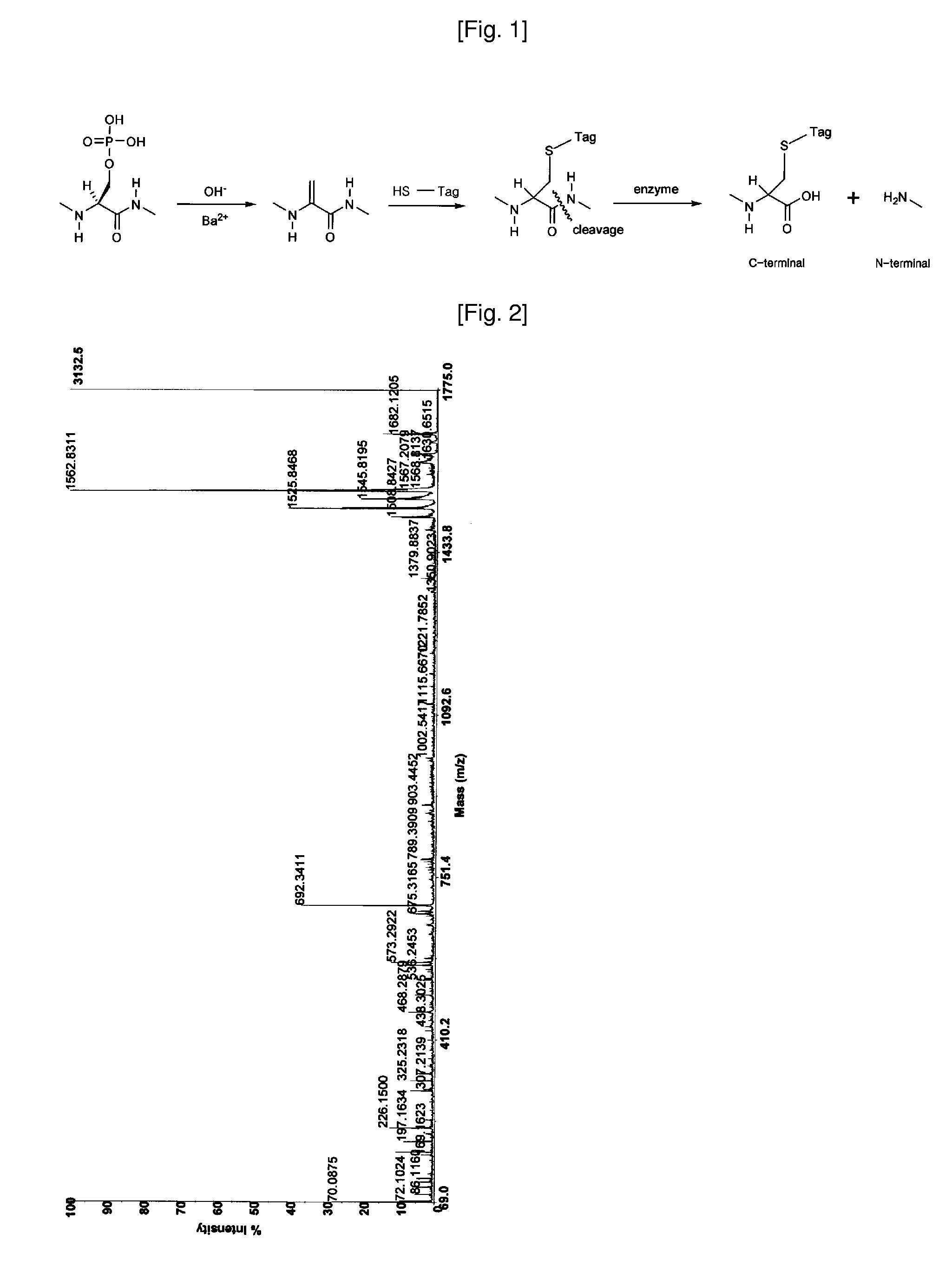In-gel tagging and in-gel digestion for phosphoproteins analysis and phosphorylation site identification
a phosphoprotein and ingel digestion technology, applied in the field of phosphoprotein site specific labeling of phosphoproteome, can solve the problems of reducing the suppression effect, unable to solve the analysis of phosphorprotein and phosphopeptide in mass spectrometry, and unable to identify the region of interest in mass analysis,
- Summary
- Abstract
- Description
- Claims
- Application Information
AI Technical Summary
Benefits of technology
Problems solved by technology
Method used
Image
Examples
example 1
[0044]Preparation of Sample Immobilized in Gel Matrix
[0045]Protein samples are extracted and prepared following a conventional method from a biological medium. The extracted proteins are denaturized with 6 M guanidine hydrochloride. Disulfide bonds of cysteine residue are reduced with tris(2-carboxyethyl)phosphine hydrochloride for about 1 h at about 37° C., and the formed thiol groups are blocked to carbanidanethyl with iodoacetaride or oxidized to sulfonic acid with performic acid following a known procedures. The prepared proteins can be separated and immobilized into polyacrylamide gel matrix following a conventional methods using in gel electrophoresis field. Polyacrylamide gel can be prepared from solutions having a variety of acrylamide concentration following a necessity. The proteins onto polyacrylamide gel can be separated by widely used 1D or 2D gel electrophoresis method, if necessary. The protein spots separated in gels are visualized by staining with silver nitrate or ...
example 2
[0046]In-gel tagging of immobilized phosphoproteins
[0047]The stained protein spots are excised from the gel, and destained with 30 mM potassium ferricyanide and 100 mM sodiumthiosulfate for gel stained with silver nitrate or with ammonium bicarbonate solution containing methanol or actonitrile for gel stained with Coomassie Blue. The gel destained is washed with acetonitrile and dried in vacuum.
[0048]Tagging solution is prepared by reduction of guanidinoethanedisulfide hydrochloride (GEDS 2HCl) with tris (2-carboxyethyl) phosphine hydrochloride (TCEP, neutralized). 0.5 M TCEP(20 μl) is mixed with 0.5M GEDS 2HCl(20 μl) under argon atmosphere. After water (2 μl) added, the reaction tube is standing for about 30 min. at about 45° C. without shaking. 5.0 N NaOH (6 μl) and 1.0 M BaCl2 (2 μl) are added to the reaction tube consecutively. The prepared tagging solution is added to the gel containing protein under argon atmosphere. The reaction tube is standing for about 3 h at about 45° C. ...
example 3
[0049]In-Gel Digestion & Mass Analysis
[0050]Combined solution of 50 mM ammonium bicarbonate (45 μl) and trypsin (0.1 μg / μl, 6 μl) is added to the dried gel for digestion, and the solution is incubated for about 12 to 18 h at 37° C. The supernatant is collected by pipette, and peptides digested are extracted by 50% acetonitrile / 0.1% trifluoroacetic acid (100 μl), and by acetonitrile (100 μl). The combined peptide solution is dried in vacuum.
[0051]The dried sample is dissolved in 20 uL of 0.1% TFA solution, and loaded onto a C18 trap column prepared (I.D 250 mm, length 30 mm, particle size 5 μm) for desalting and concentration at a flow rate 20 μl / min. Then, the peptides trapped are separated with gradient elution condition, mixed on-line with the matrix solution (CHCA in 50% acetonitrile / 0.1% trifluoroacetic acid), and loaded subsequently on sample plate for MALDI mass analysis. The eluting peptide solution can also be introduced directly to ESI mass spectrometer.
PUM
| Property | Measurement | Unit |
|---|---|---|
| flow rate | aaaaa | aaaaa |
| particle size | aaaaa | aaaaa |
| length | aaaaa | aaaaa |
Abstract
Description
Claims
Application Information
 Login to View More
Login to View More - R&D
- Intellectual Property
- Life Sciences
- Materials
- Tech Scout
- Unparalleled Data Quality
- Higher Quality Content
- 60% Fewer Hallucinations
Browse by: Latest US Patents, China's latest patents, Technical Efficacy Thesaurus, Application Domain, Technology Topic, Popular Technical Reports.
© 2025 PatSnap. All rights reserved.Legal|Privacy policy|Modern Slavery Act Transparency Statement|Sitemap|About US| Contact US: help@patsnap.com



